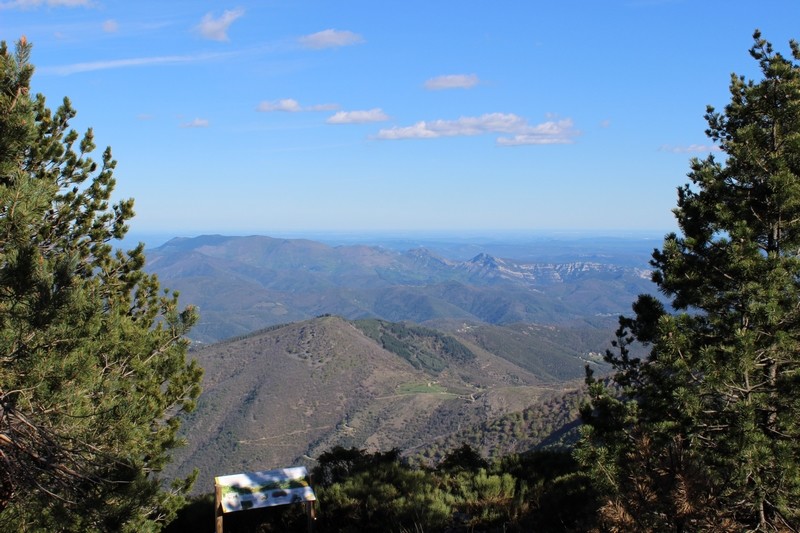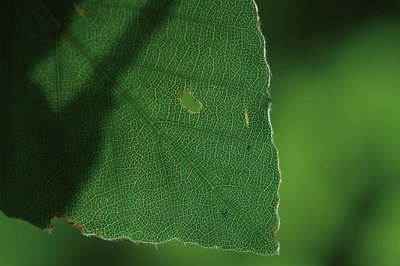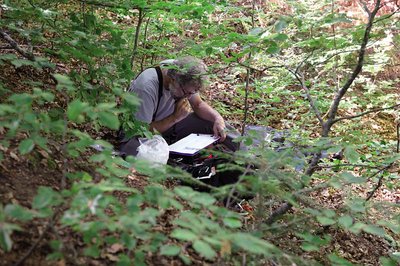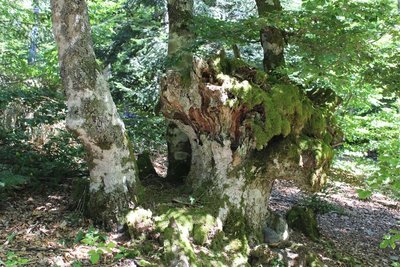
MTB 10 - La Luzette – graded red
6 points of interest

feuille de hêtre - © Emilien Herault  Flora
FloraFrom flower to fruit ...
The beech is a monoecious tree, meaning that female and male flowers are distinct but occur on the same tree. They flower in April and May; insects carry the male reproductive cells (the pollen) to the female cells.
After pollination, the flower produces seeds enclosed in soft-spined husks: beechnuts. Every three to five years, in autumn, an adult beech disperses thousands of seeds.
© Philippe Raichaud  Flora
FloraFrom the seed to the tree
Because most seeds are rich in oils, they are devoured by famished animals in the winter: squirrels, field mice, wild boar, jays, chaffinches… Any seeds still on the ground the following spring can start germinating.
© Mathieu Baconnet  Natural environment
Natural environmentTimber from stumps
Beech trees regenerate very easily; their regrowth is a number of shoots grouped together on the same stump. In the old days, this method (coppicing) was much used to obtain firewood. On the northern slope of Aulas mountain, foresters turned the former coppices into timber plantations on stumps: the new trees with their straight boles were a steady supply of wood for packaging (crates). Since the closure of these companies, the beeches have only been commercialised as firewood.
© Gaël Karczewski  Know-how
Know-howThe profession of forester
The forester is a silviculturist, meaning that s/he cultivates the forest to ensure that it is vigorous and healthy. The forester intervenes at all stages in the trees’ life cycle to encourage or oppose natural evolution, depending on the objectives. Sometimes that means momentarily protecting a species dominated by rival plants, for instance by clearing beech seedlings threatened by brambles or young firs. When a plantation reaches maturity – at about 70 years – the forester supervises fructification to make sure there are abundant flowers receiving sufficient light…
© Valère Marsaudon  Flora
FloraA genetic conservatory
This parcel, no. 308, is an official Conservatory of Genetic Resources. Its trees are vigorous and thus well adapted to the soil, climate and altitude conditions. These qualities of adaptation to the environment are inscribed in their seed, which is why some of their beechnuts are liable to be collected, dehydrated and preserved so as to be used to regenerate the beech forests of the Aigoual massif, if necessary.
 Water
WaterThe watershed
The watershed goes through the village of L’Espérou. This natural limit is also the border between the two municipalities of Val d’Aigoual and Dourbies. The rain that falls on and runs off the Valleraugue side continues to the Mediterranean. The water that flows towards Dourbies does not follow the same route and ends up in the Atlantic…
Description
From “Halle de l’Espérou”, take the road on the left.
1) At “La Halle”, take the track on the right and continue to “Les Douzes” (this section is shared with MTB 1 and 4) then to “Pueylong” (shared with MTB 4).
2) At “Pueylong”, take the track on the right to “Tabusse”, then follow on the left “Col de Montals” via “Bois de Montals”.
3) At the pass, cross the road and take the track on your left towards “Col de La Lusette” via “La Hêtraie”.
4) At the road, take the single-track trail opposite to “Bois de Villeméjane”, then to “Bois du Mas Méjean”, “Route Dhombres”.
5) Cross the road to take on your right the single track towards “Le Château”, then return to “La Halle de L'Espérou” via “Carrefour”.
This circuit is taken from the guidebook Massif de l’Aigoual, published by the communauté de communes Causses Aigoual Cévennes as part of the collection Espaces naturels gardois and the label Gard Pleine Nature.
- Departure : L’Espérou
- Arrival : L’Espérou
- Towns crossed : Dourbies, Bréau-Mars, Arphy, and Val-d'Aigoual
Forecast
Altimetric profile
Recommandations
Information desks
Tourism & national parc'house
Col de la Serreyrède, 30570 Val d'Aigoual
The Maison de l'Aigoual houses the tourism office Mont Aigoual Causses Cévennes and the Maison du Parc national. This visitor centre provides information on and raises awareness of the Cévennes National Park, its sites and events as well as the rules that must be observed in the National Park's central zone.
On site: changing exhibitions, video projections, Festival Nature events and shop Open year-round
Tourism office Mont Aigoual Causses Cévennes, Valleraugue
7 quartier des Horts, 30570 Valleraugue
This office is part of the National Park's associated tourist-information network, whose mission is to provide information on, and raise awareness of, the sites and events as well as the rules that must be observed in the National Park's central zone. : Open year-round
Transport
Access and parking
Parking :
Calculateur d'itinéraire Lio
Utilisez le calculateur liO pour organiser votre trajet en région Occitanie.
Autres régions
Calculez votre itinéraire en Auvergne Rhône Alpes sur Oùra
Biodiversité autour de l'itinéraire
Source

Report a problem or an error
If you have found an error on this page or if you have noticed any problems during your hike, please report them to us here:



